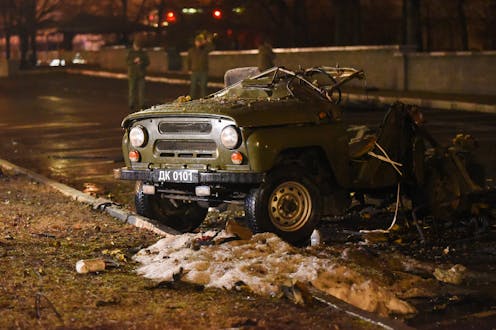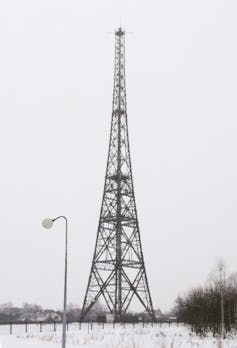What are false flag attacks – and did Russia stage any to claim justification for invading Ukraine?
Attacking your own side and blaming your foe has a long history and a firm grip on the popular imagination. But the internet makes it difficult to pull off – and less desirable.

The Russian assault on Ukraine, which began in the early hours of Feb. 24, 2022, was launched after weeks of Russian disinformation that included false claims about Ukrainian terrorist attacks, assaults on civilians and military aggression against the self-proclaimed breakaway republics in eastern Ukraine.
Observers have been on the lookout for a Russian “false flag” attack, a highly visible event that Russia could use as justification for taking military action. False flag attacks are attacks by a government on its own forces to create the appearance of hostile action by an opponent, allowing the government to broadcast images to the world of its opponent’s supposed actions.
The Kremlin and pro-government propagandists on television and social media have put out a variety of claims accusing Ukraine of carrying out bombings, blaming Ukraine for nonexistent attacks and warning of nefarious future Ukrainian and Western plots, including false flag operations. The claims include a car bombing and an alleged attempt by Ukrainian saboteurs to blow up a chemical storage facility, both in separatist eastern Ukraine. The messaging is meant to create an impression of a Ukrainian onslaught and impending humanitarian crisis.
If Russia attempted actual false flag attacks, they were one element of a larger campaign to build a narrative about Ukrainian “provocations” – unwarranted actions that require a defensive and retaliatory response. Putin invoked this logic in his memorable speech that delivered his justifications for an invasion.
Yet even in that speech, which was laden with dubious historical claims, pent-up grievances and false accusations about the Ukrainian government, the recent upsurge in fighting in the Donbas region registered almost as an afterthought. This is in contrast to Russia’s invasion in the 2008 war with Georgia, which the Kremlin justified in terms of protecting “its” citizens from Georgian attacks. Given the lack of the pretense of a plausible rationale, it is hard to avoid the conclusion that the Kremlin is unconcerned about how the world views its invasion.
Capturing the (false) flag
In the past few weeks, U.S. officials have warned several times that Russia planned a false flag attack. Such an operation, they alleged, would give Russia the pretext to invade Ukraine by provoking shock and outrage.
By exposing this plan, the Biden administration sought to undermine its emotional power and stop the Kremlin from manufacturing a casus belli, or justification for war.
But false flag attacks aren’t what they used to be. With satellite photos and live video on the ground shared widely and instantly on the internet – and with journalists and armchair sleuths joining intelligence professionals in analyzing the information – it’s difficult to get away with false flag attacks today. And with the prevalence of disinformation campaigns, manufacturing a justification for war doesn’t require the expense or risk of a false flag – let alone an actual attack.
The long history of false flag attacks
Both false flag attacks and allegations that states engage in them have a long history. The term originated to describe pirates’ wielding of friendly (and false) flags to lure merchant ships close enough to attack. It was later used as a label for any attack – real or simulated – that the instigators inflict against “friendly” forces to incriminate an adversary and create the basis for retaliation.

In the 20th century, there were several prominent episodes involving false flag operations. In 1939, agents from Nazi Germany broadcast anti-German messages from a German radio station near the Polish border. They also murdered several civilians whom they dressed in Polish military uniforms to create a pretext for Germany’s planned invasion of Poland.
That same year, the Soviet Union detonated shells in Soviet territory near the Finnish border and blamed Finland, which it then proceeded to invade.
The U.S. has also been implicated in similar plots. Operation Northwoods was a proposal to kill Americans and blame the attack on Castro, thereby granting the military the pretext to invade Cuba. The Kennedy administration ultimately rejected the plan.
In addition to these actual plots, there have been numerous alleged false flag attacks involving the U.S. government. The sinking of the USS Maine in 1898 and the Gulf of Tonkin incident in 1964 – each of which was a critical part of a casus belli – have been claimed as possible false flag attacks, though the evidence supporting these allegations is weak.
Global visibility, disinformation and cynicism
More recent and even less fact-based is the “9/11 Truth” movement, which alleged that the Bush administration engineered the destruction of the twin towers to justify restrictions on civil liberties and lay the foundation for invading Iraq. Right-wing pundits and politicians have promoted the conspiracy theory that Democrats have staged mass shootings, such as the one at a high school in Parkland, Florida, in 2018, in order to push for gun control laws.
If people believe that false flag operations happen, it is not because they are common. Instead, they gain plausibility from the widespread perception that politicians are unscrupulous and take advantage of crises.
Furthermore, governments operate in relative secrecy and have recourse to tools of coercion such as intelligence, well-trained agents and weapons to implement their agenda. It is not a huge leap to imagine that leaders deliberately cause the high-impact events that they later exploit for political gain, notwithstanding the logistical complexities, large number of people who would have to be involved and moral qualms leaders might have about murdering their own citizens.
For example, it is not controversial to note that the Bush administration used the 9/11 attacks to build support for its invasion of Iraq. Yet this led some people to conclude that, since the Bush administration benefited politically from 9/11, it therefore must have caused the attacks, despite all evidence to the contrary.
The challenge of credibility
The willingness to believe that leaders are capable of such atrocities reflects a broader trend of rising distrust toward governments worldwide, which, incidentally, complicates matters for leaders who intend to carry out false flag attacks. If the impact of such attacks has historically come from their ability to rally citizens around their leader, false flag attacks staged today may not only fail to provoke outrage against the purported aggressor, but they can also backfire by casting suspicion on the leaders who stand to benefit.
Furthermore, investigators using open source intelligence, such as the Bellingcat collective of citizen internet sleuths, make it more difficult for governments to get away with egregious violations of laws and international norms.
Even as the Biden administration attempts to blunt Russia’s ability to seize the initiative, it too faces credibility challenges. Reporters were justifiably skeptical of State Department spokesman Ned Price’s warning about Russia’s false flag plans, especially since he did not provide evidence for the claim.
Skeptics pointed to the August 2021 drone strike during the U.S. withdrawal from Kabul, which the military initially asserted was a “righteous strike” to kill a suicide bomber but that later turned out to be a mistaken attack on an innocent man and his family. It took overwhelming and undeniable evidence from media investigations before the U.S. government admitted the mistake.
[Over 140,000 readers rely on The Conversation’s newsletters to understand the world. Sign up today.]
Insofar as the Kremlin might expect to benefit from executing a false flag attack, it would be to manufacture a casus belli among Russian citizens rather than to persuade audiences abroad. Surveys have shown that the vast majority of Russians are opposed to invading Ukraine, yet they also harbor negative attitudes toward NATO.
The spectacle of a provocation aimed against Russia on state-run television might provide a jolt of support for an invasion, at least initially. At the same time, Russians are cynical about their own leaders and might harbor the suspicion that a purported attack was manufactured for political gain.
False flag alternatives
In any event, Russia had other options to facilitate the invasion. At the start of its incursion into Crimea in 2014, the Kremlin used “active measures,” including disinformation and deception, to prevent Ukrainian resistance and secure domestic approval. Russia and other post-Soviet states are also prone to claim a “provocation,” which frames any military action as a justified response rather than a first move.
By contrast, false flag operations are complex and perhaps overly theatrical in a way that invites unwanted scrutiny. Governments seeking to sway public opinion face far greater challenges today than they did in the 20th century. False flag attacks are risky, while leaders seeking to manufacture a casus belli can select from a range of subtler and less costly alternatives.
This is an updated version of an article originally published on Feb. 17, 2022.
[Get The Conversation’s most important politics headlines, in our Politics Weekly newsletter.]
Scott Radnitz does not work for, consult, own shares in or receive funding from any company or organization that would benefit from this article, and has disclosed no relevant affiliations beyond their academic appointment.
Read These Next
A Colorado guaranteed income program could help families, but the costs are high
A few hundred extra dollars a month would go a long way for many Coloradans.
West Bank violence is soaring, fueled by a capitulation of Israeli institutions to settlers’ interes
Reluctance to address settler violence is the outcome of deep social, political and cultural changes,…
Black-market oil buyers will push Venezuela for bigger discounts following US seizure – starving Mad
Venezuela relies on the black-market oil trade for a large chunk of its revenue. US enforcement actions…





